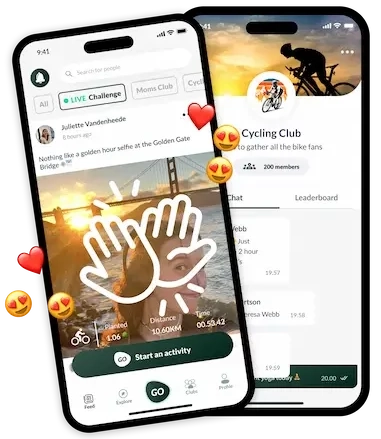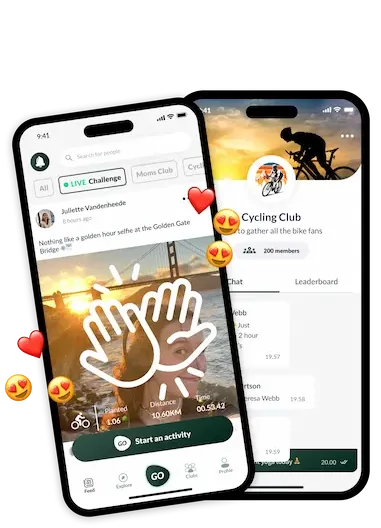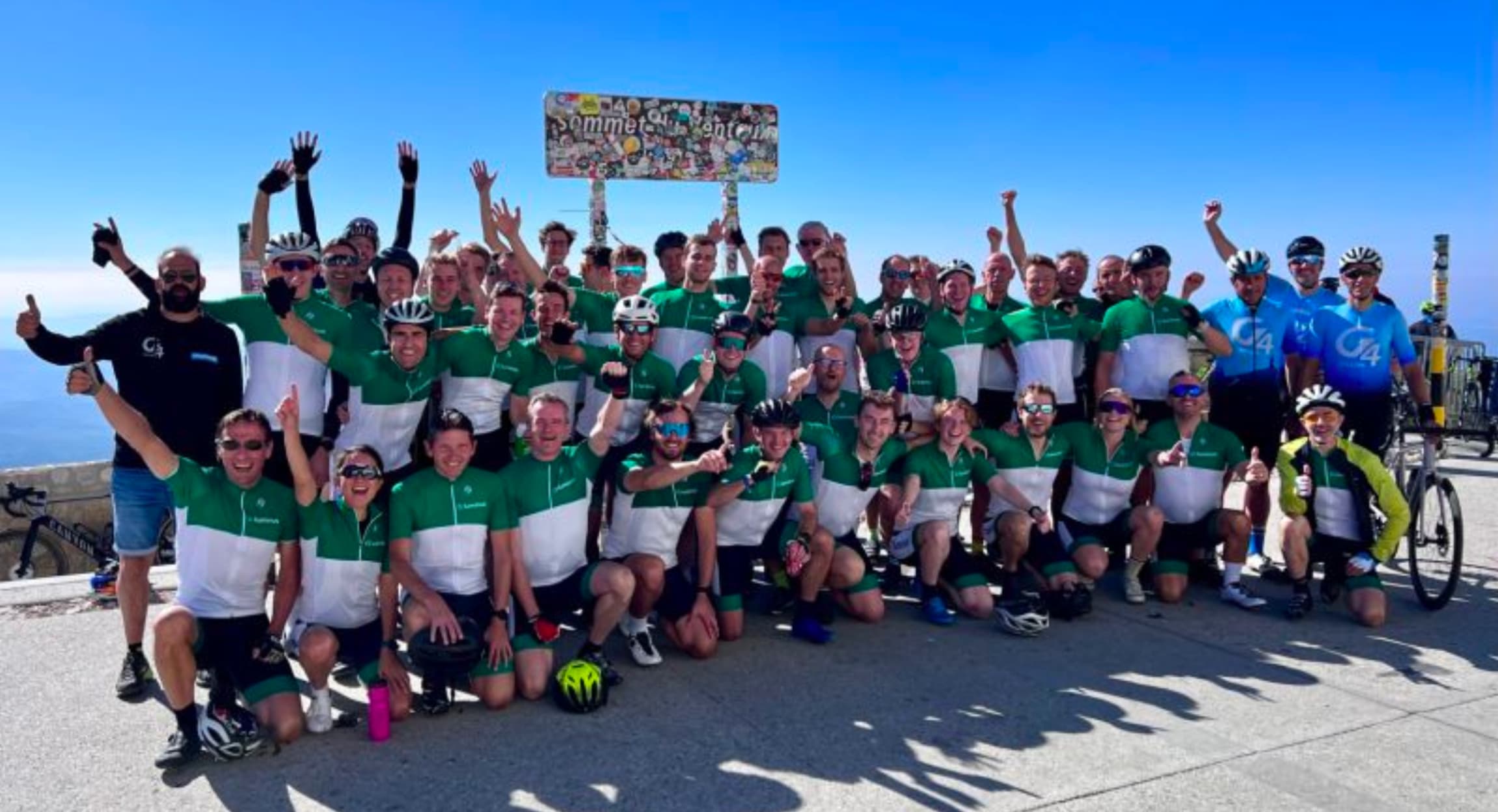Looking to engage your employees around fitness? Running and biking are two of the most popular forms of physical activity in the world. Not only are they accessible and affordable, but they can be done almost anywhere, anytime. More than just being a means of exercise, running and biking can also be a source of joy, camaraderie, and personal achievement.
With that being said, there are two globally recognized days coming up that celebrate the joys of fitness.
• Global Running Day takes place annually on the first week of June.
• World Bicycle Day is held every year on June 3rd.
These days offer the perfect opportunity to engage employees around fitness! If you’re looking for some inspiration on how you can get started, we have a few ideas for you.
5 unique ways to engage your employees around fitness
1. Start a step challenge
Step challenges are a great way to encourage employees to stay active throughout the day, and they’re easy to organize with the help of fitness trackers or apps.
• Set a goal: Determine the number of steps you want employees to aim for each day or week, and communicate this goal clearly to the team. You can base the goal on the average number of steps for your team or industry and choose a challenging but achievable target.
• Choose a tracking tool: There are a variety of fitness trackers and apps available that can help employees track their steps, such as Fitbit, Garmin, Strava, and Apple Health.
• Create a leaderboard: Use a platform like teroGO to bring the challenge together with leaderboards, fitness tracking integrations, and photo sharing as well as chat capabilities. This can be a great way to build excitement and friendly competition among the team.
• Offer incentives: Consider offering prizes or recognition for employees who reach the milestones of your choice. You can also offer team-wide rewards, such as a healthy snack or a group outing.
• Encourage participation: Promote the step challenge through emails, posters, and meetings, and encourage employees to participate by setting an example yourself. You can also provide tips for increasing daily steps, such as taking the stairs instead of the elevator, or taking a walk during breaks.
2. Start a running or biking club
Starting a running or biking club can be a great way to promote physical activity, boost morale, and build camaraderie among employees.
• Gauge interest: Send out a survey or hold a meeting to gauge interest in a running or biking club among employees. You can ask about preferred times, distances, and locations for runs or rides, as well as any concerns or suggestions.
• Choose a platform: teroGO’s platform has an integrated “Clubs” feature that allows members to share tips with each other, fitness goals, or just chat about common interests — all virtually. This is a great way to bring remote and hybrid employees together!
• Choose a leader: Identify one or more employees who are passionate about running or biking and willing to lead the club. They can help organize runs or rides, communicate with members, and ensure the group stays on track.
• Set a schedule: Decide on a regular schedule for runs or rides, such as once a week during lunch breaks or after work. Make sure the schedule is clear and consistent so that members can plan ahead.
• Provide incentives: Offer incentives for employees who participate regularly, such as recognition, prizes, or team-wide rewards. You can also offer discounts or subsidies for gear, equipment, or race entry fees.
3. Provide incentives for biking or running to work
Providing incentives for employees who bike or run to work can promote active commuting and reduce carbon emissions.
• Determine the incentives: Decide on the incentives that you want to offer to employees who bike or run to work. This can include tangible rewards such as gift cards, healthy snacks, or free bike maintenance services, as well as non-tangible rewards such as recognition, extra time off, or priority parking spots.
• Establish guidelines: Establish guidelines for the program, such as eligibility requirements, participation rules, and the timeline for earning rewards. Make sure the guidelines are clear and fair so that everyone has an equal chance to participate and succeed.
• Evaluate and adjust: Evaluate the program periodically to assess its effectiveness and make any necessary adjustments. This can include changing the incentives, updating the guidelines, or expanding the program to include more employees or more types of active commuting.
4. Provide education on the benefits of exercise
Providing education on the benefits of exercise can help motivate employees to be more physically active and improve their overall health and wellbeing.
• Determine the topics: Decide on the topics that you want to cover, such as the physical and mental health benefits of exercise, how to incorporate exercise into a busy schedule, and how to set and achieve fitness goals. Consider the needs and interests of your employees, as well as any health and wellness objectives of your company.
• Choose the format: Choose the format that works best for your workplace, such as workshops, seminars, webinars, or one-on-one coaching sessions. Make sure the format is engaging, interactive, and accessible to all employees.
• Invite experts: Invite experts in the field of health and fitness to lead the education sessions or provide expert advice. This can include personal trainers, nutritionists, physical therapists, or mental health professionals. Make sure the experts are knowledgeable, experienced, and able to communicate effectively with your employees.
• Provide resources: Provide resources to help employees learn more about the benefits of exercise and how to incorporate it into their daily routines. This can include handouts, brochures, infographics, or links to reputable websites or apps.
• Encourage participation: Encourage employees to participate in the education sessions by offering incentives or recognition for attendance or participation. You can also create a culture of learning and support by providing opportunities for employees to share their own experiences, ask questions, or provide feedback.
• Evaluate and adjust: Evaluate the effectiveness of the education program by measuring employee engagement, knowledge retention, and behavior change. Use feedback from employees to adjust the program and make improvements.
5. Organize a charity run or ride
Organizing a charity run or ride can promote physical activity, build team spirit, engage employees around fitness, and support a good cause.
• Choose a charity: Choose a charity that aligns with the values and interests of your company or your employees. Consider factors such as the charity’s mission, impact, and credibility, as well as any personal connections or experiences that your employees may have.
• Set a goal: Set a fundraising goal for the charity run or ride, and communicate it to your employees. Encourage them to participate by setting an example yourself, and by offering incentives or recognition for reaching the goal.
• Plan the route: Plan a safe and scenic route for the charity run or ride, and make sure it is suitable for all levels of fitness and experience. Consider factors such as the distance, terrain, traffic, and weather conditions, and provide adequate support and resources such as water stations, rest areas, and medical assistance.
• Recruit volunteers: Recruit volunteers to help with the organization and execution of the charity run or ride. This can include tasks such as registration, course marshalling, crowd control, and refreshment distribution.
• Promote the event: Promote the charity run or ride through social media, email, posters, or word of mouth. Encourage employees to form teams and compete for fundraising or participation awards. Provide information on the charity’s mission, impact, and how the funds raised will be used.
• Hold the event: Hold the charity run or ride on the designated date, and make sure all safety and logistical measures are in place. Provide a positive and supportive environment, and celebrate the achievements of all participants.
• Follow up: Follow up with the charity after the event, and provide them with the funds raised and any feedback or testimonials from participants. Thank everyone involved for their support and participation.
P.S. If a virtual option would suit your team better, check out teroGO for a virtual charity run/ride challenge. Employees can work towards the challenge goal on their end, record their progress with fitness trackers or manual entry, and if they reach the goal as a team, they unlock the donation to your nonprofit of choice.
Here are some fitness tips you can pass along to your employees
1. Start slow and gradually build up your speed and distance. Don’t push yourself too hard or too fast, especially if you’re new to running or biking.
2. Choose good quality shoes and equipment that fits well and provides proper support and protection.
3. Find a running or biking buddy or group that shares your interests and goals. You’ll be more likely to stick to your routine and have fun along the way.
4. Mix up your routine with different routes, terrains, and types of workouts. This will keep things interesting and prevent boredom or burnout.
You’re all set to engage employees around fitness! To bring all 5 ideas we mentioned together in one place, contact teroGO by clicking the button below and ask about hosting a themed event centered around Global Running Day or World Bicycle Day.
Written by Kelly Baker, Content Marketing at atlasGO
This website stores cookies on your computer. These cookies are used to collect information about how you interact with our website and allows us to remember you. We use this information in order to improve and customize your browsing experience and for analytics and metrics about our visitors both on this website and other media. To find out more about the cookies we use, please see our Privacy Policy.






















